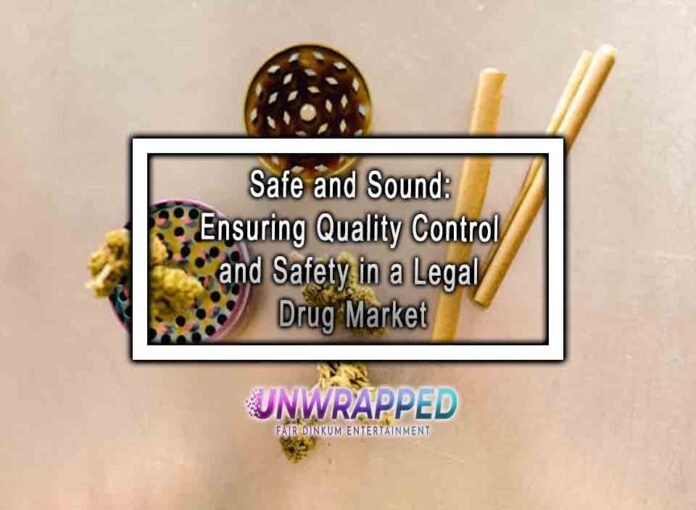One of the most critical components of legalizing drugs is ensuring that consumers are protected from harm. A legal drug market presents an opportunity to eliminate the dangers associated with unregulated substances, such as contamination, inconsistent potency, and misinformation. This article outlines how a robust system of quality control and safety standards can protect users and create a safer, healthier society.
The Dangers of the Black Market
The illegal drug trade is rife with risks that endanger consumers:
- Contamination: Drugs sold on the black market often contain dangerous adulterants or fillers, leading to fatal overdoses and long-term health issues.
- Inconsistent Potency: Without regulation, users have no way of knowing the strength of the substances they consume, increasing the risk of overdose.
- Misleading Products: Black market dealers have no accountability, often mislabeling or substituting substances to maximize profit.
Legalization offers an opportunity to eliminate these risks by introducing rigorous safety standards.
Building a System of Quality Control
1. Mandatory Drug Testing
A cornerstone of a safe legal drug market is comprehensive testing to ensure purity and consistency.
- Testing Labs: Licensed laboratories should test all substances for potency, contaminants, and harmful additives.
- Transparency: Testing results must be made publicly available, so consumers know exactly what they are purchasing.
- Regular Inspections: Random checks at production facilities and retail outlets ensure compliance with safety standards.
2. Standardized Potency
Standardizing potency helps users make informed decisions and reduces the risk of accidental overdose:
- Dose Limits: Set maximum potency levels for certain substances, particularly high-risk drugs like opioids.
- Clear Labeling: Packages must indicate the exact dosage per unit, similar to alcohol content labels on beverages.
3. Regulation of Production
Quality control begins at the production stage:
- Licensing Producers: Only licensed, regulated producers should be allowed to cultivate and manufacture drugs.
- Safe Practices: Producers must follow strict guidelines for cleanliness, equipment maintenance, and storage.
- Ingredient Sourcing: Ensure all raw materials are sourced ethically and meet safety standards.
Ensuring Consumer Safety
1. Safe Packaging
Packaging plays a significant role in minimizing risks:
- Child-Resistant Packaging: Prevent accidental ingestion by children with tamper-proof designs.
- Single-Use Packaging: For potent substances, single-dose packaging ensures users cannot accidentally take too much.
- Health Warnings: Similar to cigarette packaging, include clear warnings about the risks of misuse and addiction.
2. Age Restrictions
Restricting access to legal drugs by age is crucial:
- Minimum Age Requirements: Set age limits for purchasing and using drugs, as is done with alcohol and tobacco.
- Identity Verification: Require ID checks for all purchases to prevent underage access.
3. Safe Consumption Guidelines
Educating users on safe consumption practices reduces harm:
- Dosage Recommendations: Include clear instructions on safe doses, particularly for first-time users.
- Usage Warnings: Highlight potential interactions with other substances, such as alcohol or prescription medications.
Creating a Culture of Accountability
1. Consumer Education
Empowering consumers with knowledge is key to fostering safety:
- Public Awareness Campaigns: Launch campaigns to educate the public about safe drug use, similar to anti-drunk driving initiatives.
- Interactive Tools: Develop apps or websites where consumers can learn about the substances they are using, their effects, and potential risks.
2. Legal Recourse
A regulated market ensures accountability for manufacturers and retailers:
- Product Recalls: Establish mechanisms for recalling unsafe or mislabeled products.
- Liability Protections: Hold producers and sellers liable for harm caused by negligence or poor practices.
The Role of Technology in Quality Control
1. Blockchain for Transparency
Blockchain technology can track the entire supply chain, ensuring transparency and preventing diversion into the black market:
- Tracking Production: Each batch of a substance can be tracked from production to sale, ensuring accountability.
- Consumer Access: QR codes on packaging can link to detailed information about the product’s origin, testing results, and more.
2. Digital Monitoring Tools
Digital tools can enhance oversight:
- Inventory Management Systems: Monitor stock levels to detect anomalies, such as missing quantities that might be diverted illegally.
- Real-Time Reporting: Allow consumers to report adverse effects, creating a database for continuous monitoring of product safety.
Learning from Other Industries
The pharmaceutical, alcohol, and food industries provide valuable lessons in quality control:
- Pharmaceuticals: Strict testing and regulatory oversight in the drug industry ensure consistency and safety.
- Alcohol: Standardized alcohol content labeling helps consumers make informed choices.
- Food: Transparency in sourcing and production has become a standard expectation, driven by consumer demand.
Adapting these practices to the legal drug market can set a high standard for safety and accountability.
Examples of Success
1. Canada’s Cannabis Regulations
Canada’s legalized cannabis market includes mandatory lab testing for potency and contaminants, ensuring a safer product for consumers (Health Canada).
2. Switzerland’s Heroin-Assisted Treatment
In Switzerland, medical-grade heroin is provided under strict supervision, eliminating the risks of contamination and variable potency (Swiss Federal Office of Public Health).
3. Uruguay’s Cannabis Control
Uruguay requires all cannabis sold legally to be tested and registered, reducing the risk of adulterants and black-market competition (BBC News).
Overcoming Challenges
1. Black Market Competition
While regulation reduces the black market, illegal operators may continue to exist. Competitive pricing and accessibility are key to driving consumers to the legal market.
2. Compliance Enforcement
Regular inspections and penalties for non-compliance ensure producers and retailers follow safety standards.
3. Public Trust
Building public trust in the safety of regulated drugs requires transparency, consistent enforcement, and clear communication.
A Vision for Safety
A well-regulated drug market is not only about legality—it’s about creating a safer, healthier society where users are protected from harm. By implementing rigorous quality control measures, governments can:
- Reduce the risks associated with drug use.
- Build trust in the legal system.
- Shift the narrative from punishment to protection.
The blueprint for a safe legal drug market already exists. It’s time to adapt it to the realities of drug use and create a system that prioritizes human lives over outdated ideologies.
See Also: Taking the Power Back: How Legalization Undermines Organized Crime










